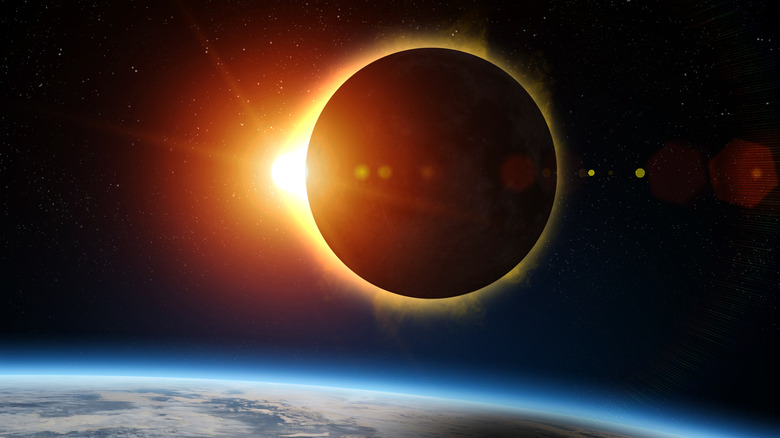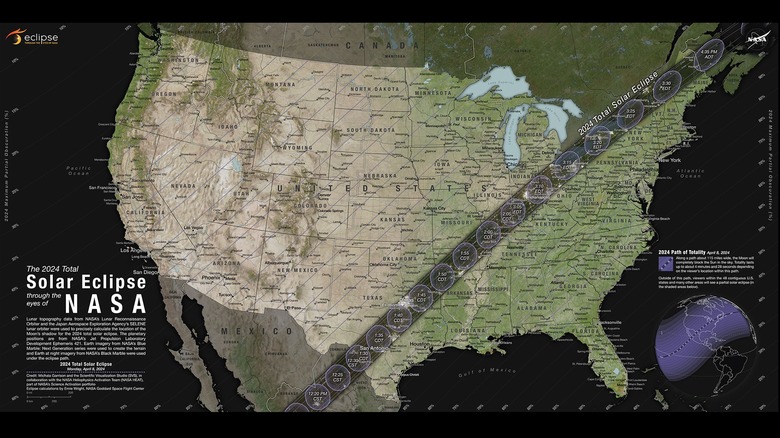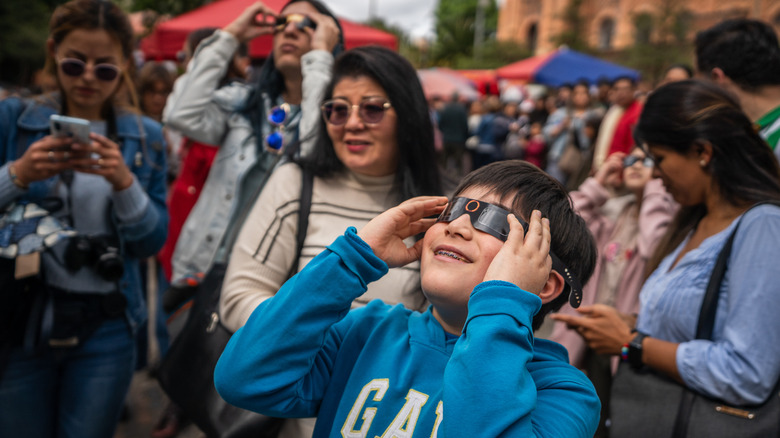2024 Eclipse: Here's What Time It Happens, And Where You'll Need To Be
On April 8, 2024, skygazers across North America — including parts of Mexico, the United States, and Canada — are set to witness a total solar eclipse. A truly rare phenomenon, the last time the continental United States witnessed a total solar eclipse was seven years ago, in August 2017. And if you miss this eclipse, the wait for the next total solar eclipse will be longer, with the next one not happening until August 23, 2044.
Given the long wait for the next total solar eclipse, more people are likely to witness the event compared to the 2017 event. To put things into perspective, more than 215 million people from the U.S. viewed the 2017 event, roughly 88% of U.S. adults. This time around, the path of this eclipse is much wider than the one followed by the last eclipse, making it easier to see for more people. If that wasn't enough, the 2024 eclipse will be viewable from more urban areas.
The 2024 total solar eclipse will follow a path starting from the Pacific coast of Mexico, traveling northeast through the United States, and finally reaching the eastern provinces of Canada. The duration of totality, when the sun is completely obscured by the moon, will vary along the path. Nevertheless, if you intend to witness this rare celestial phenomenon firsthand, it is important you be at the right place at the right time. To make lives easier for you, listed below are some ideal locations from where you should be able to easily witness the total solar eclipse.
2024 Eclipse prime viewing locations
For those eager to witness this celestial event, strategic location planning is crucial. NASA's eclipse map (shown above) outlines the path of totality, marking regions where the eclipse will be most pronounced. Some prime viewing locations in the United States include cities like Dallas, Little Rock, Cleveland, Buffalo, and parts of Maine. Each of these locations will witness the total solar eclipse for varying durations, with some fortunate spots experiencing nearly three minutes of complete darkness.
Other locations where you will be able to witness the total solar eclipse include Paducah, Kentucky; Erie, Pennsylvania; Lancaster, New Hampshire; and Carbondale, Illinois. In addition to these areas, the 2024 solar eclipse will also be visible in some parts of Tennessee and Michigan.
The partial solar eclipse will start in Dallas, Texas, at around 12:23 p.m. CDT and will make its way up America, reaching Clevland, Ohio, around 1:59 p.m. EDT. During this time, certain areas will experience a total solar eclipse. The North American phase of the eclipse will end once it reaches the Atlantic Ocean, next to Newfoundland, Canada, at around 5:16 p.m. NDT. If you can't reach any of these locations, you can always catch the action online or via live TV channels.
2024 Solar eclipse safety precautions you need to take
While there is no harm in getting excited about the upcoming total solar eclipse, it is also important to keep all safety requirements in mind before you set out to witness it. It is never safe to directly look at the solar eclipse during the partial phase without proper eye protection. The recommended tools that will let you safely witness the partial phase of the eclipse include special-purpose eclipse glasses and handheld solar viewers. Note that sunglasses are not designed to view solar eclipses and may still cause eye damage if used to view them.
If you have eclipse eyewear handy, it is always better to have it on all the time, even during the darkest moments of the total eclipse. Even when there is no solar eclipse, it is unsafe to view any part of the sun without using a solar filter, and doing so may result in severe eye injury.
If you intend to enjoy this rare spectacle with family and friends on April 8, 2024, now is a good time to plan your itinerary and home in on a viewing location of your choice. Given how rare this event is, chances are high that you may encounter large crowds at popular parks and observatories.


